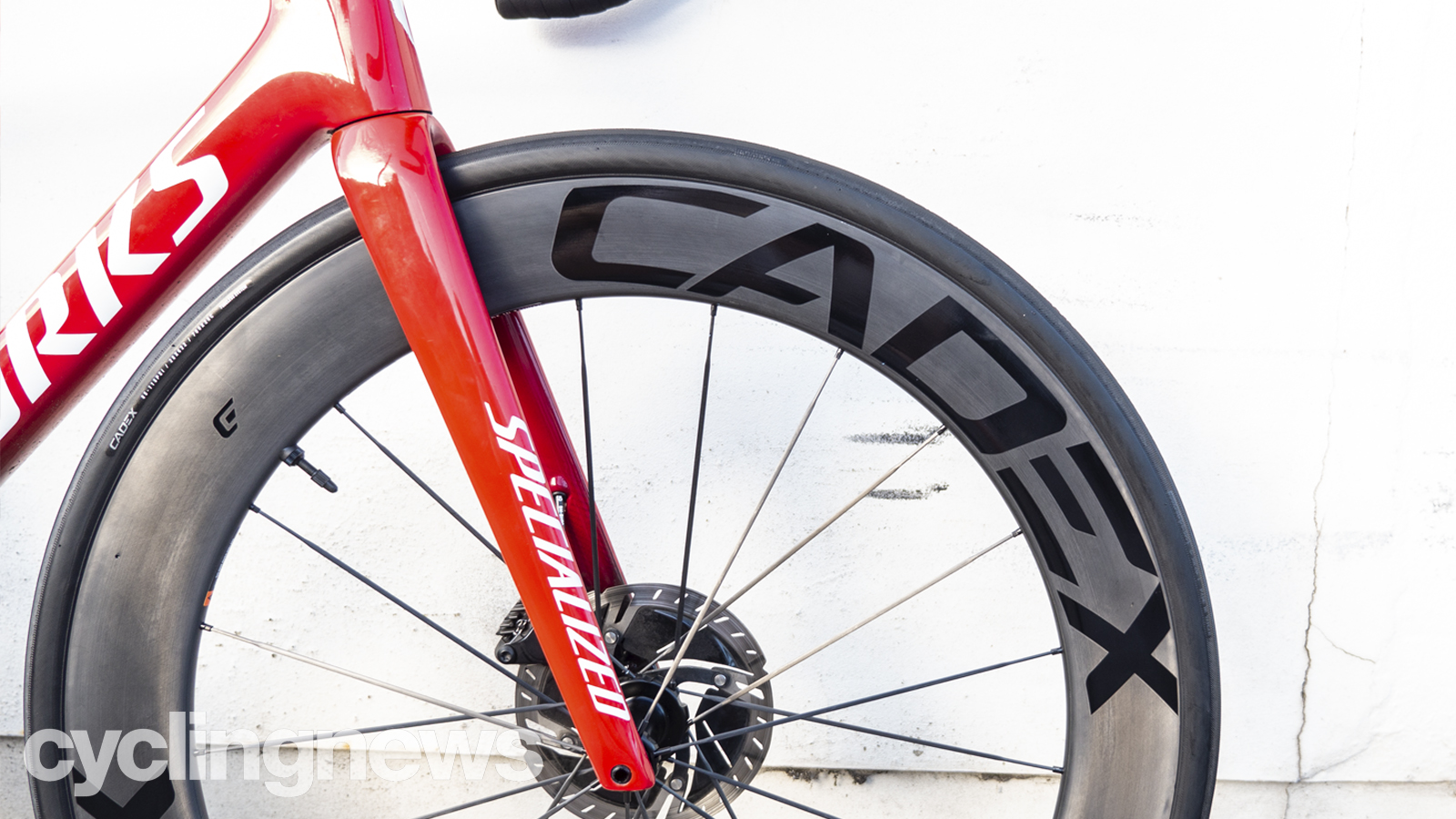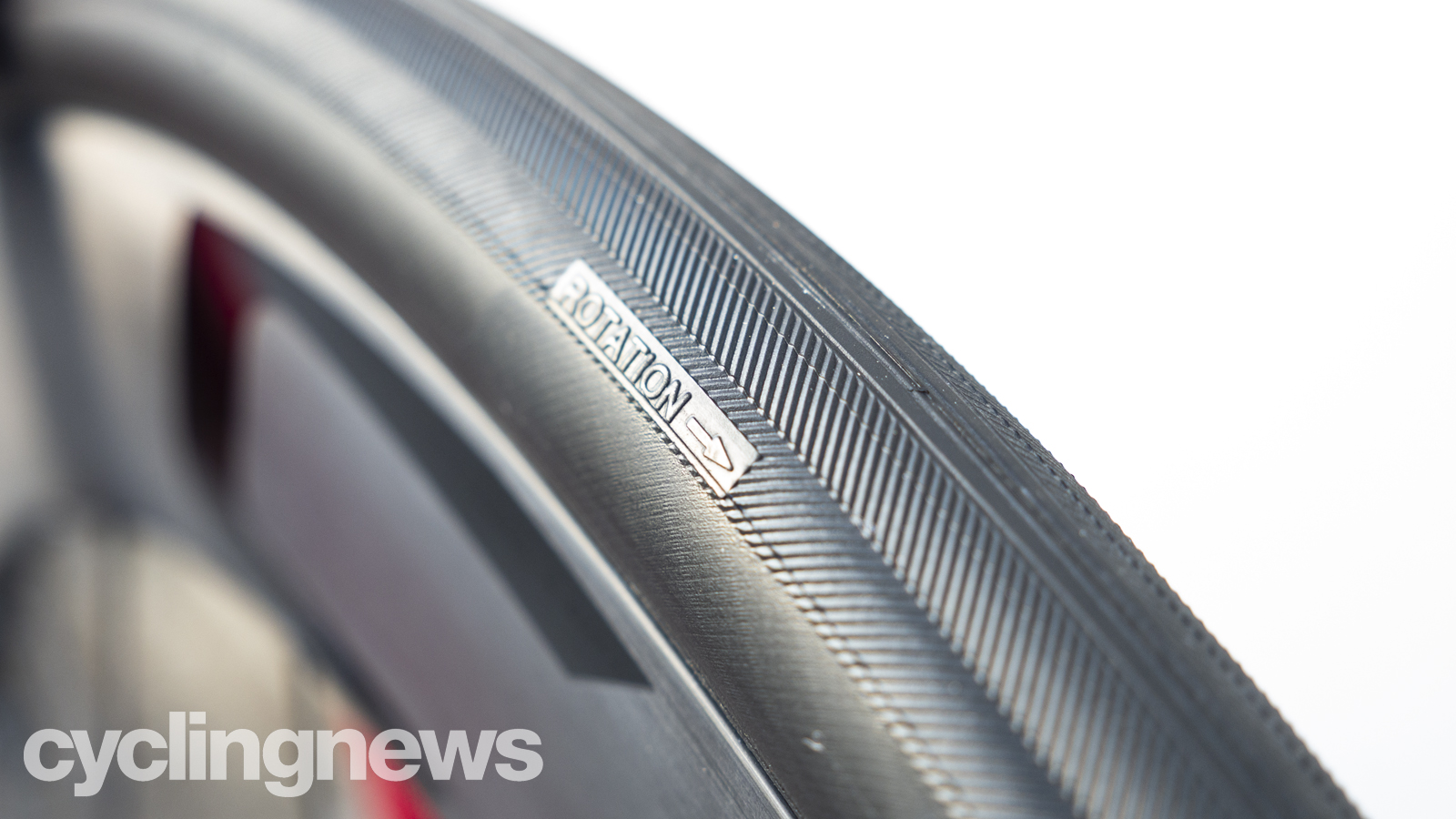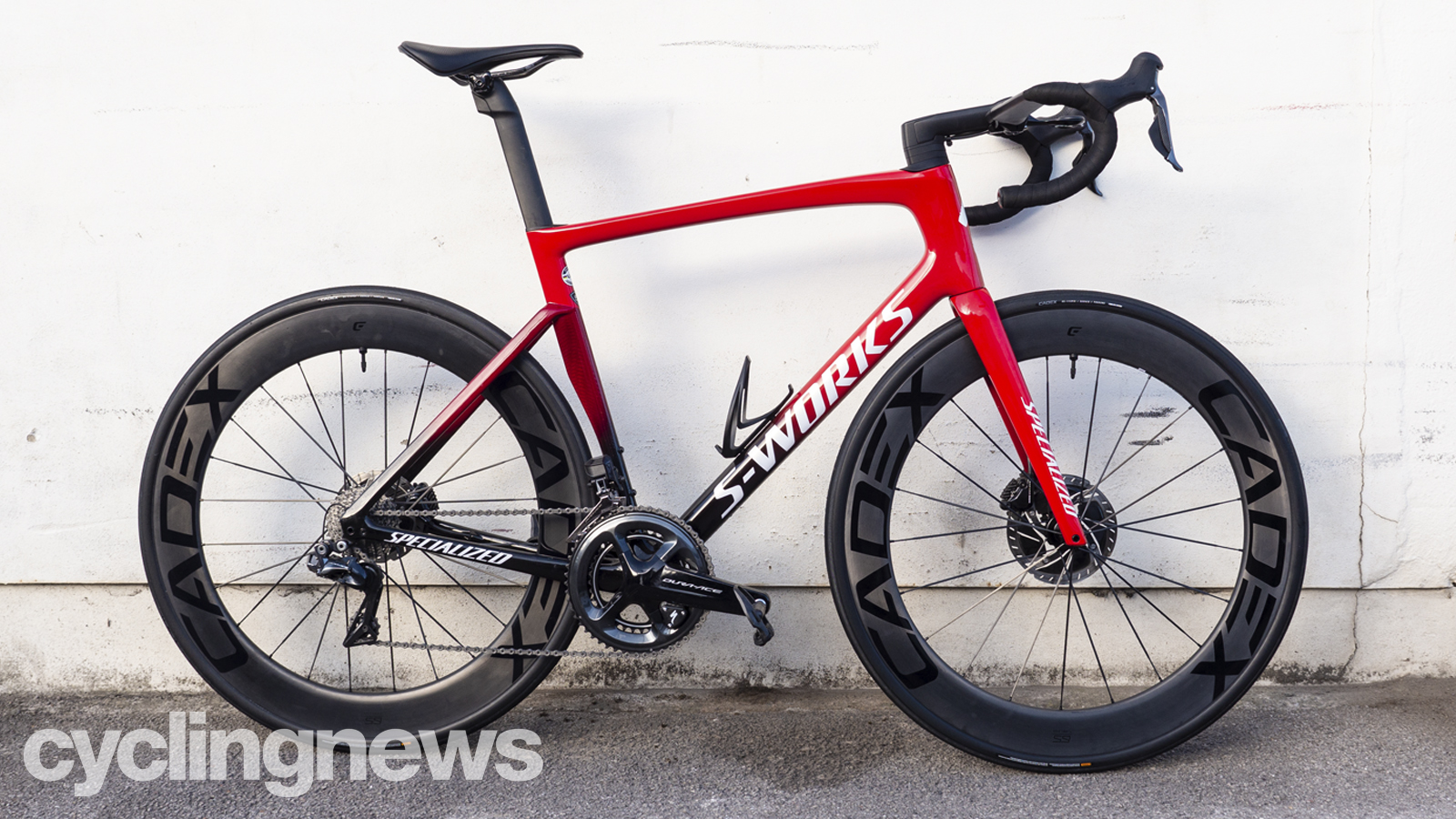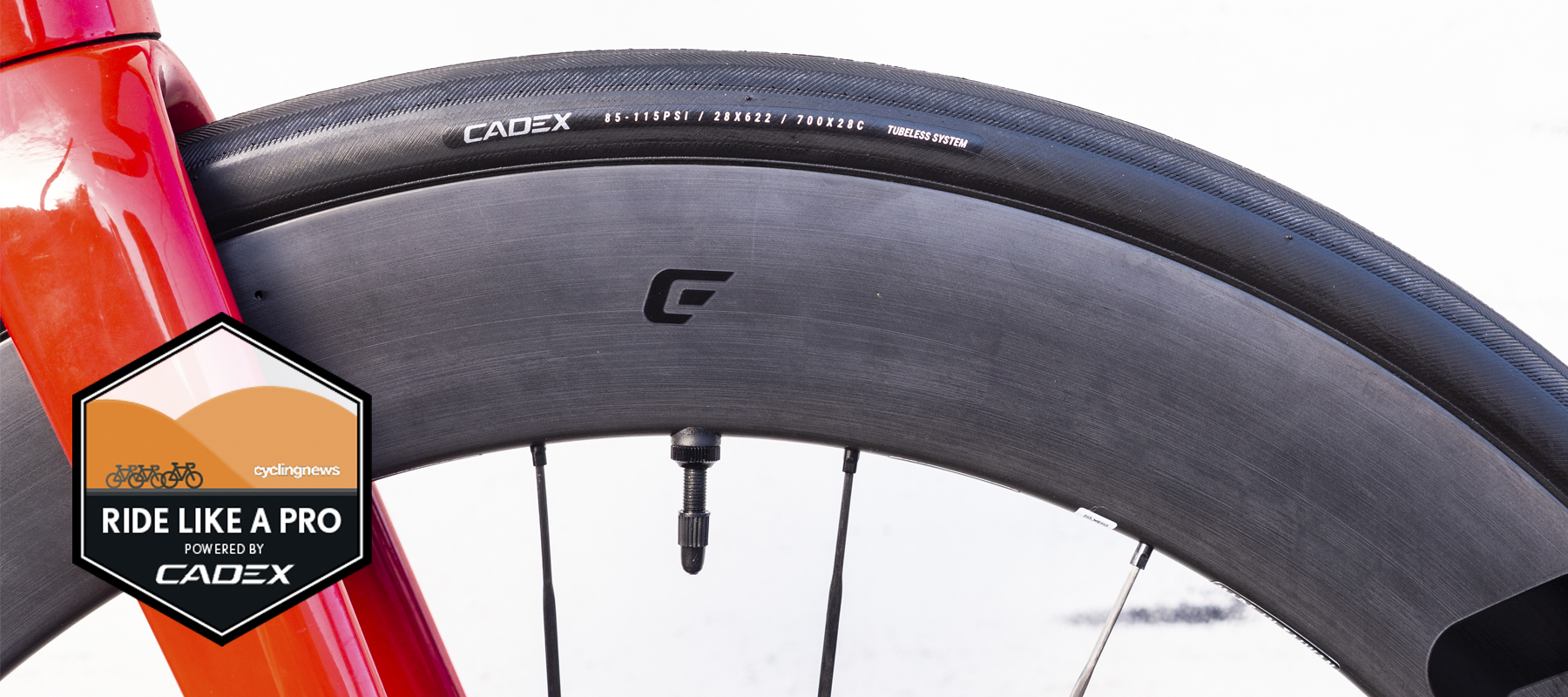Early Verdict
Crosswinds twitchiness aside, the CADEX 65 is a fast, aero wheelsystem with a competitive weight, super simple tubeless setup and a specification list that will win any game of Top Trumps, oh and the black-on-black colour scheme looks incredible.
Pros
- +
Simple tubeless set up
- +
Competitively light considering the 65mm depth
- +
Effortless flatland speed
Cons
- -
Twitchy in crosswinds
You can trust Cyclingnews
CADEX is a relatively new components subsidiary, borne out of the bicycle manufacturing firm, Giant Bicycles. Officially announced in 2019, the brand went to market with a very small menu of products, but each one of them is aimed at the upper echelons of the sport. With copious amounts of carbon fibre in its range, the brand launched a single saddle model called the Boost, a single tyre model called Race, as well as a range of wheels which aim to compete with the very best road bike wheels from competitors.
Within the wheel range, there's a time trial wheelset including a rear disc wheel which pairs with a four-spoke front. The best lightweight wheels from CADEX come in the form of the 42mm deep wheels, aptly named the CADEX 42, and are the wheels you'll ride if you purchase the Giant TCR Advanced Pro 0.
However, the wheels pictured here are the CADEX 65. You may have guessed that they measure 65mm deep, which makes them the aero road wheel in the lineup, although, with a weight of 1,522g for the pair, they're not all that uncompetitive in the weight stakes either.
Also, rather than wheelset, Giant and CADEX call it a 'wheelsystem', citing the holistic approach in which the wheels and tyres were designed. I'll allow them this liberty here and refer to the 65 as a wheelsystem from here on in.
In the short time since they arrived at Cyclingnews' home-office headquarters, I've managed just an hour's worth of ride time on the wheels, so any feedback here can - and certainly should - be taken with a pinch of salt, but I'll also discuss specs, comparisons with competition, as well as my experience of the initial setup, for which I chose tubeless.

Design and specifications
The CADEX 65 is the aero road wheelsystem in the range. It measures 65mm deep, and has a trend-leading internal width of 22.4mm. Many of the recently released wheels on the market, such as new Roval wheels and the Enve Foundation wheels which all measure 21mm, or the DT Swiss ARC wheelset which measure 20mm. CADEX's own 42 wheels measure just 19.4mm.
I've already mentioned the weight, but in case you're a skim reader, here it is again: 1,522 grams, which is 21 grams heavier than claimed, but I'm including the rim strip and tubeless valve. This isn't lightweight by any means, but in comparison to other aero wheelsets on the market, they're not too bad. Of course, you're not buying 65mm deep wheels for the gram savings, per se, but it's nice to know you're not carrying round a lead weight. For comparison, Roval's CLX64 weighs 1,567g, Enve's shallower 5.6 SES weigh in at 1,576g, and DT Swiss' ARC 1100 DICUT 62mm weigh 1,676g.
Much of this weight saving is likely to come thanks to CADEX's use of carbon-fibre spokes, which are aerodynamically shaped, directional, true-able, and are claimed to save around two grams per spoke over a comparable stainless option. Two grams might not sound like a lot, but you're looking at 45 of them in total, as the front is laced with 21 and the rear with 24, which for the mathematicians out there, adds up to a respectable saving of 90 grams.
The spokes are laced using something CADEX calls Dynamic Balanced Lacing (DBL). In essence, this means the hub and spokes are laced with an even tension when ridden, rather than when static and unloaded. The supposed claim is superior transmission stiffness and efficiency. The theory sounds logical enough, but in the riding thus far, it's not something that jumped out as noticeable.
The spokes are straight pull and are laced to low-friction hubs, which, according to CADEX, are designed to keep bearing tension isolated. These hubs feature precision sealed cartridges, a ratchet driver borrowed from DT Swiss, as well as compatibility with Shimano HG or SRAM XDR freehub bodies.

Both the 42 and 65 rims are designed with a hookless bead. CADEX says this provides the best flow transition from the tyre to the sidewall of the rim, resulting in reduced aerodynamic loss when compared to standard hook bead rims as well as greater durability. Put more simply, the join between rim and tyre is smooth, which means airflow is uninterrupted, which is faster. This smoothness is certainly more visible on the 42 wheelsystem - which has an external rim width of 23mm - when fitted with 25c tyres. The 65 wheelsystem has an external rim profile of 26mm, and when fitted with 28c tyres, it is a little more lightbulb-esque in shape.
- Best road bike tyres: fast-rolling, ultra-grippy tyres for training and racing
- Best tubeless road tyres: Our pick of the top tubeless road tyres
The shape of the rims is slightly different to what I've come to expect, too. Rather than the super blunt profile that many of today's wheelsets possess, CADEX's 65 is a little less rounded in this regard. I'm not sure if this affects the ride or aerodynamics either way, but it's an observation nonetheless.
Both CADEX 42 and CADEX 65 wheelsystems are available in rim- and disc-brake guises, manufactured in tubeless or tubular format.
Performance
The wheelsystem is set up tubeless-ready straight from the box, complete with rim strip and tubeless valves pre-fitted, and the whole setup process was a complete breeze and a big check in CADEX's favour.
Getting the tyres onto the rim took a little bit of effort, but I'd say no more than two minutes worth, which included checking to ensure the tyre was in the centre channel where necessary. It was then at this point that the 'wheelsystem' approach really evidenced itself; without the need for sealant or even an air compressor, the tyre seated with just two pumps of air from a track pump. All in, it took a total of around 15 minutes worth of tool-time, including fitting centre-lock disc brake rotors and a Shimano cassette. On behalf of lazy (and busy) home mechanics from around the world, I will say "thank you CADEX".
Pleasingly, when I then went to check the tyre pressures the following afternoon, the 80psi I had opted for was still there waiting for me, suggesting the tyres had sealed perfectly and well enough to prevent the air leakage that can be all too common with even the best tubeless road tyres.

Once out on the bike - in this instance, the S-Works Tarmac SL7 - the on-the-road performance was equally impressive. The expected flatland speed was easily noticeable and made itself apparent after just a few minutes of riding. However, perhaps more surprisingly, climbing was relatively unhindered too - I even managed to PR a climb that I've ridden several times previously on all manner of lightweight bikes and wheels.
Of course, this is just one ride's worth of anecdotal evidence, so remember to bear that in mind.
It wasn't all rainbows and unicorns, however, and during that first test ride, the front wheel was noticeably twitchy when it came to crosswinds. Of course, anything with a 65mm depth is going to act like a sail to a certain extent, it was more reactive than other aero wheelsets I've tried lately. The only consolations are that it was a particularly breezy day, and I was running a reasonably high 80psi in a 28c tyre. Again, remember; pinch of salt.
Early Verdict
The CADEX 65 is a fast, aero wheelsystem with a competitive weight, super simple tubeless setup and a specification list that will win any game of Top Trumps, oh and the black-on-black colour scheme looks incredible.
While the crosswinds twitchiness is a cause for further investigation, the CADEX 65s are shaping up to be a really good pair of wheels.
Tech spec: CADEX 65
- Price: £2,500 / US$3,400 / AU$4,500
- Weight: 1,522g
- Tubeless: Yes
- Spokes: Aero bladed carbon (21 front, 24 rear)
- Bearings: Sealed cartridge

Josh is Associate Editor of Cyclingnews – leading our content on the best bikes, kit and the latest breaking tech stories from the pro peloton. He has been with us since the summer of 2019 and throughout that time he's covered everything from buyer's guides and deals to the latest tech news and reviews.
On the bike, Josh has been riding and racing for over 15 years. He started out racing cross country in his teens back when 26-inch wheels and triple chainsets were still mainstream, but he found favour in road racing in his early 20s, racing at a local and national level for Somerset-based Team Tor 2000. These days he rides indoors for convenience and fitness, and outdoors for fun on road, gravel, 'cross and cross-country bikes, the latter usually with his two dogs in tow.
What is a hands on review?
'Hands on reviews' are a journalist's first impressions of a piece of kit based on spending some time with it. It may be just a few moments, or a few hours. The important thing is we have been able to play with it ourselves and can give you some sense of what it's like to use, even if it's only an embryonic view.
